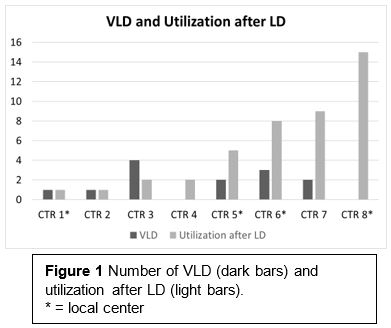Positive Relationship between Transplant Center Volume and Utilization of Hard to Place Liver Allografts after Late Declines
1Department of Transplant Surgery, UCSF, San Francisco, CA
2Weill Cornell Medical Center, New York, NY.
Meeting: 2018 American Transplant Congress
Abstract number: 573
Keywords: Allocation, Liver transplantation, Resource utilization
Session Information
Session Name: Concurrent Session: Non-Organ Specific: Economics, Public Policy, Allocation, Ethics - 3
Session Type: Concurrent Session
Date: Tuesday, June 5, 2018
Session Time: 4:30pm-6:00pm
 Presentation Time: 4:54pm-5:06pm
Presentation Time: 4:54pm-5:06pm
Location: Room 4C-4
Given ongoing waitlist mortality and the high rates of liver discard in the US we wanted to investigate late declines (LD), and very late declines (VLD) of liver allografts in our OPO to look for correlation with center transplant activity.
Methods:
We defined LD as a decline after the donor operation started, and VLD after donor cross clamp. We performed a retrospective review of activity of the 8 most active transplant centers in our OPO between 07/2016 and 10/2017. The OPO provided LD and VLD data. Transplant center activity was obtained from the Scientific Registry of Transplant Recipients. We quantified 1) the total # of liver transplants per center, 2) LD per center, 3) VLD per center, and 4) the number of livers each center utilized after a LD by another center. For statistical analysis, Pearson correlations were performed.
Results: The number of LD and VLD varied dramatically in our OPO, as did the number of liver allografts utilized after another center's LD (figure 1). Some of the centers with the highest number of VLD were not local centers, and only 2 of the VLD were by local centers. Importantly, there is a positive correlation between a center transplant volumes and willingness to utilize a liver after a LD (figure 2). High volume centers had a very low rate of LD or VLD per organ transplanted.
Discussion:
LD and VLD result in challenging livers to reallocate, and risk organ discard. Centers with higher volume utilized more liver allografts after LD by another center. Many late LD and VLDs are from non-local centers. In the share 35 era we must be mindful of these challenges to ensure effective sharing and organ discard is minimized. A larger study comparing centers in over performing to centers in underperforming OPOs would be valuable.
CITATION INFORMATION: Knox J., Braun H., Syeed S., Halazun K., Roll G. Positive Relationship between Transplant Center Volume and Utilization of Hard to Place Liver Allografts after Late Declines Am J Transplant. 2017;17 (suppl 3).
To cite this abstract in AMA style:
Knox J, Braun H, Syeed S, Halazun K, Roll G. Positive Relationship between Transplant Center Volume and Utilization of Hard to Place Liver Allografts after Late Declines [abstract]. https://atcmeetingabstracts.com/abstract/positive-relationship-between-transplant-center-volume-and-utilization-of-hard-to-place-liver-allografts-after-late-declines/. Accessed January 5, 2026.« Back to 2018 American Transplant Congress


